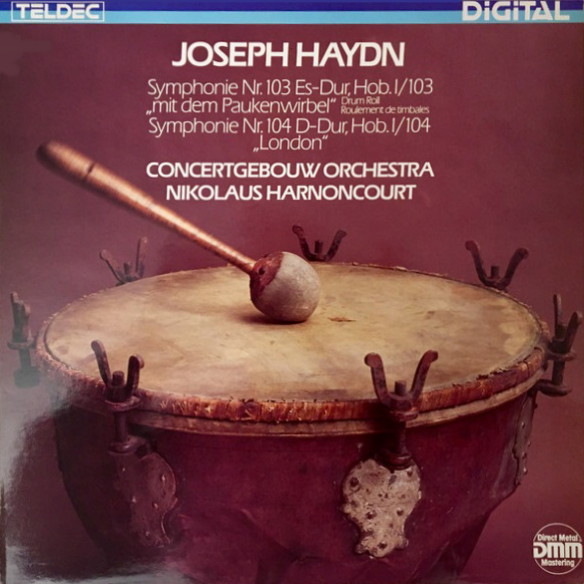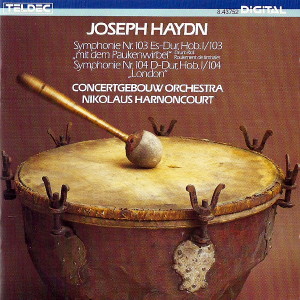 |
1 LP -
6.43752 AZ - (p) 1987
|
 |
| 1 CD -
8.43752 ZK - (p) 1987 |
|
| Franz Joseph
Haydn (1732-1809) |
|
|
|
|
|
|
|
Symphonie Nr. 103 Es-dur,
Hob. I/103 "mit dem Paukenwirbl"
|
|
30' 46" |
|
| - Adagio - Allegro con
spirito |
10' 04" |
|
A1 |
- Andante
più tosto Allegretto
|
9' 45" |
|
A2 |
- Menuett
|
5' 12" |
|
A3 |
| - Finale: Allegro con
spirito |
5' 45" |
|
A4 |
Symphonie
Nr. 104 D-dur, Hob. I/104 "London"
|
|
26' 59" |
|
- Adagio - Allegro
|
9' 14" |
|
B1 |
| - Andante |
7' 21" |
|
B2 |
| - Menuetto: Allegro - Trio |
3' 38" |
|
B3 |
- Finale spiritoso
|
6' 46" |
|
B4 |
|
|
|
|
| CONCERTGEBOUW ORCHESTRA,
AMSTERDAM |
|
| Nikolaus
Harnoncourt, Dirigent |
|
|
Luogo
e data di registrazione
|
| Großer
Saal, Concertgebouw, Amsterdam (Olanda)
- giugno 1987 |
|
Registrazione
live / studio
|
| studio |
Producer
/ Engineer
|
Wolfgang
Mohr / Helmut A. Mühle
|
Prima Edizione CD
|
| Teldec
- 8.43752 ZK - (1 cd) - 58' 15" - (p)
1987 - DDD |
Prima
Edizione LP
|
Teldec - 6.43752
AZ - (1 lp) - 58'
15"
- (p) 1987
- Digital
|
|
|
Notes
|
“This wonderful man
never disappoints us.
Every idea of his inventive and
passionate spirit was executed by the
orchestra with rare precision and
received by the audience with equal
delight.” Thus the reviewer of the
“Morning Chronicle” on 15th April
1795, reporting on the appearance of
probably the most famous composer of
the time, whose own diary entry
shortly after this last of his London
benefit concerts read: “I made four
thousand florins this evening. That`s
only possible in England.” It
was certainly possible for Haydn, at
any rate. During his two visits to
England, 1791-92 and 1794-95, he found
ideal conditions for his music, and he
was able to adapt to them and exploit
them to his, advantage - with huge
success.
London at the end of the 18th century
was indisputably the musical capital
of Europe, after Parisian music life
had collapsed in the wake of the
French Revolution. Music publishing
and instrument building were
flourishing in London, and above all
there was already an unusually well
developed and diverse musical life -
public, open to everyone and governed
by the rules of a free market. The
audiences that poured into the city’s
rnain concert halls came as a result
from all strata of society, such as
was not the case elsewhere. The
composer who wanted to thrive in
London had to take this point into
consideration, alongside the immediate
performing conditions such as the
composition of the orchestra and the
size of the concert hall.
Haydn, who was a tireless experimenter
- the cliché ofthe fusty old “Papa
Haydn” is far from the truth -
doubtless saw these circumstances as
an appealing challenge. And in his
London Symphonies he did indeed reach
the climax of a development he had
begun shortly before in the Paris
Symphonies: the development of a
symphonic style that would appeal to
“connoisseurs” and the general
music-lover alike, that would be
popular without relinquishing even a
fraction of its artistic
sophistication.
To achieve this aim in his penultimate
symphony, no. 103, he made use of a
special resource - he
borrowed from folk music. This work
(like no. 104, it was first
performed in the “Opera Concerts” in
the King’s Theatre in the spring of
1795) simply abounds with Croatian and
Hungarian folk melodies from regions
close to the Esterhazy court where
Haydn worked for some 30 years. It is
interesting to see how Haydn does not
just quote folk tunes: he integrates
them into his own style.
The dance-like first subject of
the first movement,
for instance, takes it justification
from the context, as it were (the same
is true of the second subject): Haydn
derives it from the motifs of the slow
introduction that opens with a solo
drum roll - a feature that attracted
the greatest attention at the work’s
premiere, and of course gave the
symphony its nickname. It
becomes clear that this introduction
is in fact the true centre of the
whole movement when it reappears in
the course of the Allegro, if not
before.
The integration and stylization of
folk music also play an important role
in the other movements. The Andante is
a subtly scored set of variations on
two closely related themes that
clearly belong to the realm of folk
music. In the minuet,
the boisterous yodelling figures
are stylized by the strings. And in
the finale, Haydn derives a second
subject, a Croatian folk tune, from
the main subject.
Haydn blends the quotations so
perfectly with his own style that it
is no surprise when he does without
them for the most part in his last
symphony, no. 104. The “folk sound"
here, with the exception of the
Croatian melody in the ponderous
finale, is of Haydn`s own creation,
and is united with the utmost skill.
The cheerful theme on which the entire
first movement is based is thus
subjected to treatment that is almost
excessive. And the rather simpler idea
of the Andante gives scarcely any hint
of the distant regions of passion and
danger to which it will he taken in
the course of the movement. What did
the American musicologist Charles
Rosen say? - “The more popular Haydn’s
music became, the more academic was
his style.”
Norbert
Meurs
Translation: Clive Williams
|
|
Nikolaus
Harnoncourt (1929-2016)
|

|

|
|